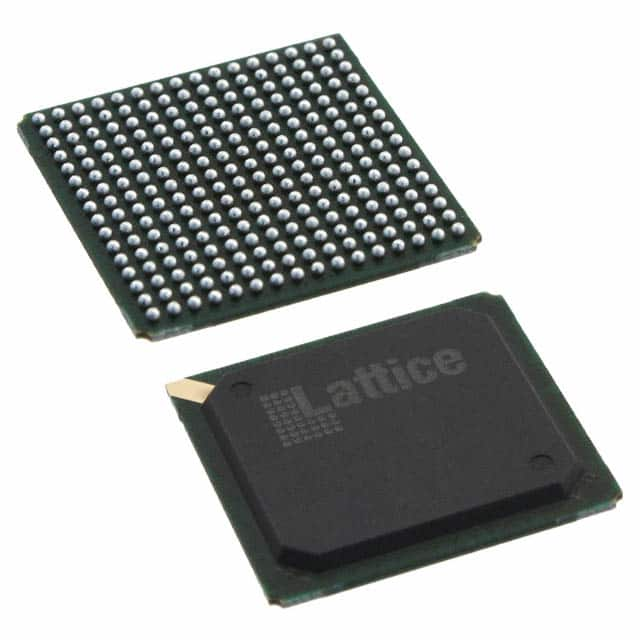LFXP10C-4FN256I
Product Overview
Category
The LFXP10C-4FN256I belongs to the category of Field Programmable Gate Arrays (FPGAs).
Use
FPGAs are integrated circuits that can be programmed and reprogrammed to perform various digital functions. The LFXP10C-4FN256I is specifically designed for applications requiring high-performance and low-power consumption.
Characteristics
- High-performance FPGA with low power consumption
- Flexible and reprogrammable design
- Suitable for a wide range of applications
- Compact package size
Package
The LFXP10C-4FN256I comes in a 256-pin FineLine BGA (Ball Grid Array) package.
Essence
The essence of the LFXP10C-4FN256I lies in its ability to provide a customizable and efficient solution for digital circuit design and implementation.
Packaging/Quantity
The LFXP10C-4FN256I is typically packaged individually and is available in various quantities depending on the manufacturer or distributor.
Specifications
- Logic Cells: 10,080
- Flip-Flops: 20,160
- Block RAM: 360 Kbits
- DSP Slices: 96
- Maximum Operating Frequency: 400 MHz
- I/O Pins: 256
- Voltage Range: 1.2V - 1.5V
Detailed Pin Configuration
The LFXP10C-4FN256I has a total of 256 pins, each serving a specific purpose in the FPGA's functionality. A detailed pin configuration diagram can be found in the product datasheet provided by the manufacturer.
Functional Features
- High-speed performance
- Low power consumption
- Reconfigurable design
- Support for various communication protocols
- On-chip memory resources
- Built-in digital signal processing capabilities
Advantages and Disadvantages
Advantages
- Flexibility in design and implementation
- High-performance computing capabilities
- Low power consumption
- Support for various communication protocols
- On-chip memory resources enhance efficiency
Disadvantages
- Initial setup and programming may require expertise
- Limited availability of alternative models with similar specifications
Working Principles
The LFXP10C-4FN256I operates based on the principles of reconfigurable logic. It consists of a matrix of programmable logic blocks interconnected by configurable routing resources. The FPGA can be programmed using hardware description languages (HDLs) to implement desired digital circuits and functions.
Detailed Application Field Plans
The LFXP10C-4FN256I finds applications in various fields, including but not limited to: - Telecommunications - Data processing and storage - Industrial automation - Medical devices - Aerospace and defense systems - Automotive electronics
Detailed and Complete Alternative Models
While the LFXP10C-4FN256I offers high-performance and low-power consumption, there are alternative FPGA models available in the market that cater to different requirements. Some notable alternatives include: - Xilinx Virtex UltraScale+ - Intel Stratix 10 - Microsemi PolarFire
These alternative models provide varying levels of performance, power consumption, and features, allowing designers to choose the most suitable FPGA for their specific application needs.
In conclusion, the LFXP10C-4FN256I is a high-performance FPGA with low power consumption, offering flexibility and reprogrammability. Its compact package size and extensive range of applications make it a versatile choice for various industries. While it has advantages such as high-speed performance and support for multiple communication protocols, it may require expertise for initial setup and programming. Designers can consider alternative models based on their specific requirements.
Lista 10 Vanliga frågor och svar relaterade till tillämpningen av LFXP10C-4FN256I i tekniska lösningar
Sure! Here are 10 common questions and answers related to the application of LFXP10C-4FN256I in technical solutions:
Q: What is LFXP10C-4FN256I? A: LFXP10C-4FN256I is a field-programmable gate array (FPGA) manufactured by Lattice Semiconductor.
Q: What are the key features of LFXP10C-4FN256I? A: Some key features include 10,080 Look-Up Tables (LUTs), 240 Kbits of embedded memory, 96 I/O pins, and support for various communication protocols.
Q: What applications can LFXP10C-4FN256I be used for? A: LFXP10C-4FN256I can be used in a wide range of applications such as industrial automation, telecommunications, automotive systems, medical devices, and more.
Q: How can I program LFXP10C-4FN256I? A: LFXP10C-4FN256I can be programmed using Lattice Diamond or Lattice Radiant software tools provided by Lattice Semiconductor.
Q: What voltage levels does LFXP10C-4FN256I support? A: LFXP10C-4FN256I supports both 3.3V and 1.2V voltage levels, making it compatible with a variety of systems.
Q: Can LFXP10C-4FN256I interface with other components or devices? A: Yes, LFXP10C-4FN256I has multiple I/O pins that can be used to interface with other components or devices, including sensors, displays, and communication modules.
Q: Does LFXP10C-4FN256I support any specific communication protocols? A: Yes, LFXP10C-4FN256I supports various communication protocols such as SPI, I2C, UART, and Ethernet.
Q: Can LFXP10C-4FN256I be used for real-time applications? A: Yes, LFXP10C-4FN256I can be used for real-time applications due to its high-speed performance and low-latency capabilities.
Q: What are the power requirements for LFXP10C-4FN256I? A: LFXP10C-4FN256I typically operates at a voltage range of 1.14V to 1.26V and requires a stable power supply with appropriate current capabilities.
Q: Are there any development boards or evaluation kits available for LFXP10C-4FN256I? A: Yes, Lattice Semiconductor offers development boards and evaluation kits specifically designed for LFXP10C-4FN256I, which provide a convenient platform for prototyping and testing.


